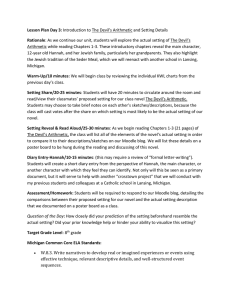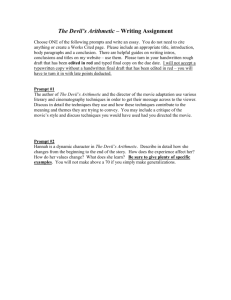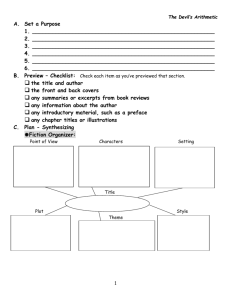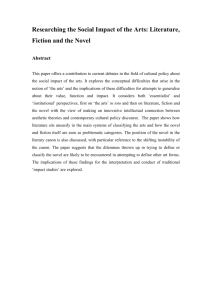The Devil`s Arithmetic
advertisement
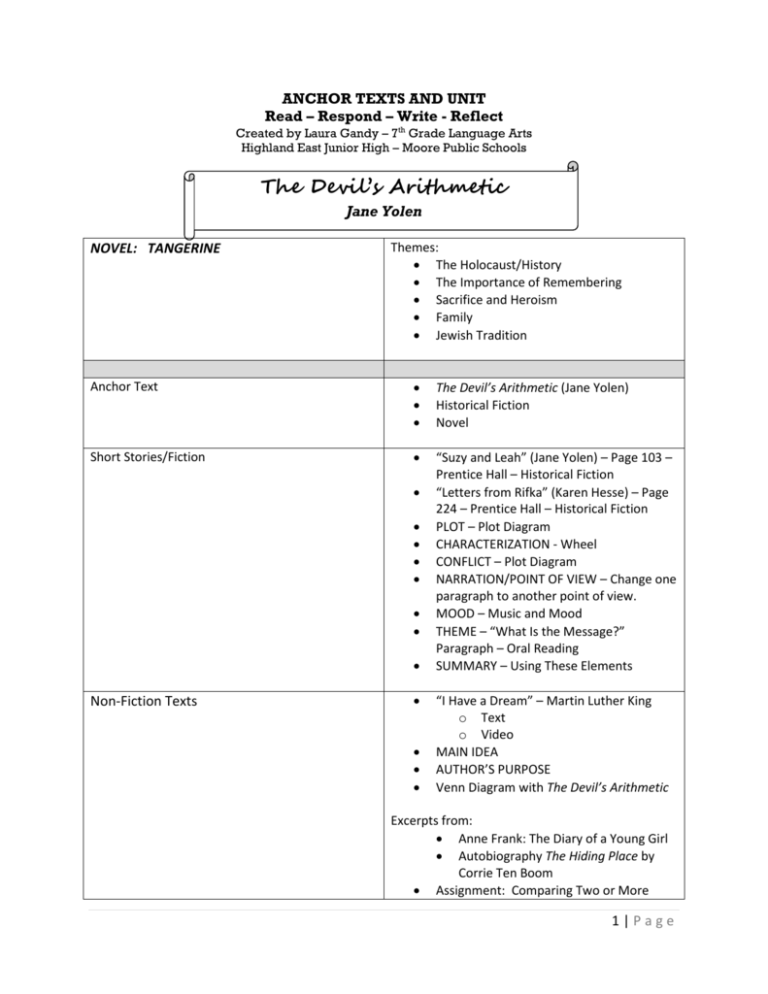
ANCHOR TEXTS AND UNIT Read – Respond – Write - Reflect Created by Laura Gandy – 7th Grade Language Arts Highland East Junior High – Moore Public Schools The Devil’s Arithmetic Jane Yolen NOVEL: TANGERINE Themes: The Holocaust/History The Importance of Remembering Sacrifice and Heroism Family Jewish Tradition Anchor Text The Devil’s Arithmetic (Jane Yolen) Historical Fiction Novel Short Stories/Fiction “Suzy and Leah” (Jane Yolen) – Page 103 – Prentice Hall – Historical Fiction “Letters from Rifka” (Karen Hesse) – Page 224 – Prentice Hall – Historical Fiction PLOT – Plot Diagram CHARACTERIZATION - Wheel CONFLICT – Plot Diagram NARRATION/POINT OF VIEW – Change one paragraph to another point of view. MOOD – Music and Mood THEME – “What Is the Message?” Paragraph – Oral Reading SUMMARY – Using These Elements Non-Fiction Texts “I Have a Dream” – Martin Luther King o Text o Video MAIN IDEA AUTHOR’S PURPOSE Venn Diagram with The Devil’s Arithmetic Excerpts from: Anne Frank: The Diary of a Young Girl Autobiography The Hiding Place by Corrie Ten Boom Assignment: Comparing Two or More 1|Page Texts (learning.blogs.nytimes.com) Informational Articles Facebook and Auchwitz Article SOAPSTONE Article TONE AUTHOR’S PURPOSE PERSPECTIVE/POINT OF VIEW Poetry “Holocaust” by Sudeep Pagedar (Companion Texts) “First They Came” by Neimoller “The Lost Generation” “Train Tune” (Louise Bogan) – Page 591 – Prentice Hall “MLK – Martin Luther King” (Raymond Patterson) – Page 600 – Martin Luther King TPCASTT LITERARY TERMS PERSPEC TIVE THEME/MESSAGE Memory Presentation “First They Came” by Neimoller Vocabulary The Devil’s Arithmetic Vocabulary and Spelling Test Commonly Confused Words Greek and Latin Roots Speaking and Listening – Oral Communication Inner/Outer Circle Novel Discussion – Facebook in Auchwitz Article & The Devil’s Arithmetic Poetry Recitation “What Is the Message?” Paragraph Reading Research Martin Luther King Quotes The Holocaust Voluntary Reading Daily at Bell in Reading Class (1st Hour) 1 Novel and Novel Project Each Month OCCT Practice Daily at Bell in English Class (2nd Hour) o Pre-Test 2|Page o o Media: One Item Annotation Per Day Keep in Bell Work in Binder for OCCT Study National Holocaust Museum Website Corrie Ten Boom Website Dr. Suess – political cartoons – “I reject milk from Holstein cows as Non-Aryan” “Second Creation” ‘Put your finger here, pa . . . “ “Snake in the grass” ?? *** Defying Genocide: Choices that Saved Lives by United States Holocaust Memorial Museum 3|Page SPECIFIC LITERACY/READING STANDARDS: Identify Central Theme Detail Supporting Central Theme Analyze Plot How Events or Ideas are Developed/Elaborated Figurative Language Connotative Language Technical Meanings of Words Author’s Point of View Comparing and Contrasting Text to Other Text/Media Assertions Backed or Not by Evidence Analyzing Topics and Themes in Different Texts ELA PASS STANDARDS: Vocabulary • Words in Context (1.1) • Word Origins (1.2) • Idioms and Comparisons (1.3) Comprehension/Critical Literacy • Literal Understanding (3.1) • Inferences and Interpreting (3.2) • Summary and Generalization (3.3) • Analysis and Evaluation (3.4) Literature • Literary Genres (4.1) • Literary Elements (4.2) • Figurative Language/Sound Devices (4.3) Research and Information • Accessing Information (5.1) • Interpreting Information (5.2) READING SKILLS infer the meaning of unfamiliar words or phrases from context clues Apply knowledge of synonyms, antonyms, and multimeaning words to assist comprehension Decode words in text using roots, prefixes, and suffixes Preview the selection to predict content and purpose Clarity understanding using strategies such as rereading, questioning, and summarizing Determine the central idea and supporting ideas Compare and contrast ideas Identify cause-and-effect relationships Make inferences and draw conclusions about characters and events Recognize distinguishing features of genres Identify and analyze characters and settings Understand the development of plot and the resolution of conflicts Describe structural elements of poetry and drama Identify and interpret figurative language and literary techniques Distinguish between fact and opinion Select and use a variety of appropriate sources to find information Determine the author’s purpose or position analyze how the author’s viewpoint affects the text and recognize propaganda Evaluate the ways in which the author organizes and presents ideas Determine the lesson, message, or theme of a story Relate reading to prior knowledge, experience, and new situations Connect ideas, themes, and issues in or across texts GRAMMAR SKILLS 3.1.a Principal parts of verbs to form tenses 3.1.b Make subjects and verbs agree 3.1.c Use nominative, objective, and possessive pronouns correctly 3.1.d Make pronouns agree with their antecedents 3.1.h.1 Use infinitive, gerund, participial, and prepositional phrases to vary sentence structure 3.2.b.14 Use comma to set of parenthetical expressions 3.2.b.19 Use semi-colon to separate two independent clauses 3.2.b.20 Use semi-colon between independent clauses joined by conjunctive adverbs and transitional expressions followed by a comma 3.3.1 Identify and revise run-on sentences and fragments 3.3.d Write simple, compound complex, and compoundcomplex sentences observing comma and semi-colon rules 3.3.d Identify and correct faulty parallel structure in writing 4|Page

